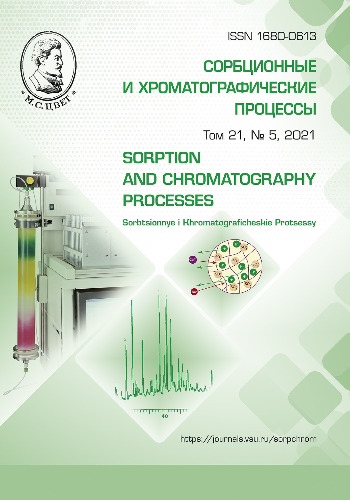Polydimethylsiloxane-based surface-layer block-porous sorption systems
Abstract
The need to design block-porous sorption systems with polymeric material as the surface layer is due to the increased requirements for the qualitative and quantitative analyses of atmospheric air for volatile organic compounds (VOCs) near industrial enterprises. Bulk porous sorbents have a low rate of mass transfer, which limits their use for analytical purposes. The aim of this work was to develop surface-layer block-porous sorption systems based on polymethylsiloxane (PMS), a polymer material, and study their properties.
The sorption systems described in this article are based on block-porous material with a thin film of polymethylsiloxane deposited on its surface. Initially, we developed some sorption system samples. The preparation process included the formation of a base block with certain geometric features, surface pretreatment by etching and oxidation, and the deposition of a film of polymer material. We noted that the untreated sample had the thickest film, as the adhesion to the smoother surface was greater, compared to the other samples.
To carry out the sorption, a hexane in air gas mixture was passed through the obtained samples. We observed that under the selected sorption conditions (the component concentration in the initial gas mixture was 0.3 mg/l, the gas mixture volume was 20 ml), on average, 94% of the component was sorbed by the block porous sorption systems. When we used powdered sorption material, almost 100% of the material was sorbed.
The component was extracted from the sorption systems by static thermal desorption at 120°C for 30 minutes. Samples of sorption systems with the smallest PMS film thickness and the highest porosity after film deposition showed the highest degree of extraction. It should be noted that the N-AW chromatone modified with PMS demonstrated the lowest degree of extraction during desorption. As can be seen from the research data, the porosity, i.e. the free space within the sorption system, increases the efficiency of mass exchange processes and, consequently, the desorption efficiency. The study showed the reusability of the samples, as evidenced by the stable values of the extraction rates during sorption (the relative standard deviation does not exceed 4%).
Downloads
References
Egorova O.S., TunakovaYu.A., Vestnik Kazanskogo tekhnologicheskogo universi-teta, 2014, Vol. 11, No 9, pp. 210-217.
DrugovYu.S., Rodin A.A. Probopodgo-tovka v ekologicheskom analise, M., BI-NOM, Knowledge laboratory, 2013, 755 p.
Platonov I.A., Drugov Yu.S., Rodin A.A. Prakticheskaya analiticheskaya khimiya, Samara, "Porto-Print", 2015, 550 p.
Rodinkov O.V., Moskvin L.N., Journal analiticheskoy khimiii, 2012, Vol. 67, No 10, pp. 814-822.
Safin A.I., Igolkin A.A., Shakhmatov E.V., Vector nauki TSU, 2013, No 2, pp. 200-202.
PonomarevYu.K., Ulanov A.M., Izvesti-ya Samarskogo nauchnogo centra RAN, 2009, Vol. 11, No 3, pp. 214-218.
Chegodaev D.E., Muratov A.G. Patent RF, no. 2038118, 1995
Tupikova E.N. Diss. cand. chem. nauk. Samara, 2003, 153 p.







